ESP Abarth 500 2015 Owner handbook (in English)
[x] Cancel search | Manufacturer: ABARTH, Model Year: 2015, Model line: 500, Model: Abarth 500 2015Pages: 215, PDF Size: 19.08 MB
Page 59 of 215

TTC SYSTEM (Torque
Transfer Control)
It is an integral part of the ESC system.
This system improves the transfer of
drive torque to the wheels,
guaranteeing safer and more sporty
driving, especially when cornering, far
more able to prevent understeer.
System activation
It is turned off by pressing the button
again or when the vehicle is switched
off (ignition key in the OFF position).
WARNING
31) When the ABS intervenes and
you feel the brake pedal pulsating,
do not reduce the pressure, but
hold it down firmly and
confidently; in doing so you will
brake in the shortest distance
possible, depending on the
current road conditions.
32) To obtain the maximum
efficiency of the braking system, a
bedding-in period of about 500
km is needed: during this period it
is better to avoid sharp, repeated
and prolonged braking.
33) If the ABS system intervenes,
this indicates that the traction
of the tyres on the road is about
to reach its limit. You must slow
down to a speed compatible with
the available traction.
34) The ABS cannot overrule the
natural laws of physics, and
cannot increase the grip available
according to the condition of
the road.35) The ABS cannot prevent
accidents, including those due to
excessive speed on corners,
driving on low-grip surfaces or
aquaplaning.
36) The capability of the ABS must
never be tested irresponsibly and
dangerously, in such a way as
to compromise personal safety
and the safety of others.
37) For the correct operation of the
ABS, it is essential that the tyres
are of the same make and type on
all wheels, in perfect condition
and, above all, of the specified
type and dimensions.
38) For the correct operation of the
ASR system, it is essential that
the tyres are of the same make
and type on all wheels, in perfect
condition and, above all, of the
specified type and dimensions.
39) The ASR system cannot overrule
the natural laws of physics, and
cannot increase the grip available
according to the condition of
the road.
40) The ASR system cannot prevent
accidents, including those due to
excessive speed on corners,
driving on low-grip surfaces or
aquaplaning.
60AB0A0226
55
The system is activated by pressing
button A fig. 60 in the dashboard.
Activation is signalled by the LED in the
TTC button lighting up.
Page 60 of 215
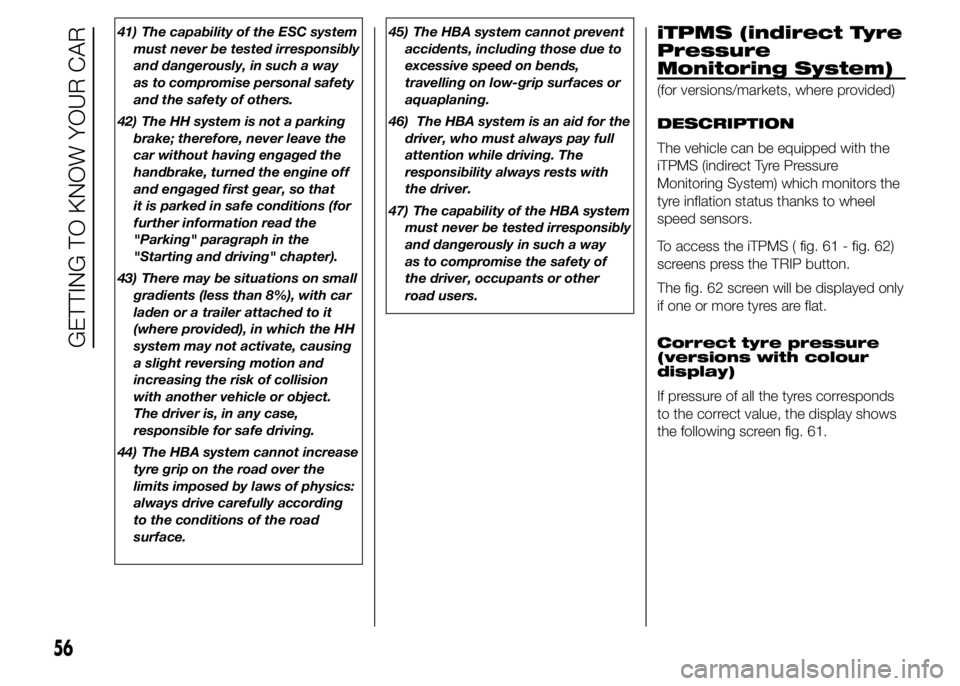
41) The capability of the ESC system
must never be tested irresponsibly
and dangerously, in such a way
as to compromise personal safety
and the safety of others.
42) The HH system is not a parking
brake; therefore, never leave the
car without having engaged the
handbrake, turned the engine off
and engaged first gear, so that
it is parked in safe conditions (for
further information read the
"Parking" paragraph in the
"Starting and driving" chapter).
43) There may be situations on small
gradients (less than 8%), with car
laden or a trailer attached to it
(where provided), in which the HH
system may not activate, causing
a slight reversing motion and
increasing the risk of collision
with another vehicle or object.
The driver is, in any case,
responsible for safe driving.
44) The HBA system cannot increase
tyre grip on the road over the
limits imposed by laws of physics:
always drive carefully according
to the conditions of the road
surface.45) The HBA system cannot prevent
accidents, including those due to
excessive speed on bends,
travelling on low-grip surfaces or
aquaplaning.
46) The HBA system is an aid for the
driver, who must always pay full
attention while driving. The
responsibility always rests with
the driver.
47) The capability of the HBA system
must never be tested irresponsibly
and dangerously in such a way
as to compromise the safety of
the driver, occupants or other
road users.iTPMS (indirect Tyre
Pressure
Monitoring System)
(for versions/markets, where provided)
DESCRIPTION
The vehicle can be equipped with the
iTPMS (indirect Tyre Pressure
Monitoring System) which monitors the
tyre inflation status thanks to wheel
speed sensors.
To access the iTPMS ( fig. 61 - fig. 62)
screens press the TRIP button.
The fig. 62 screen will be displayed only
if one or more tyres are flat.
Correct tyre pressure
(versions with colour
display)
If pressure of all the tyres corresponds
to the correct value, the display shows
the following screen fig. 61.
56
GETTING TO KNOW YOUR CAR
Page 63 of 215

EOBD SYSTEM
The EOBD (European On Board
Diagnosis system) carries out a
continuous diagnosis of the
components of the car related to
emissions. It also alerts the driver, by
turning on the warning light
on the
instrument panel together with relevant
message on the display, when these
components are no longer in peak
conditions (see chapter "Warning lights
and messages").
The goal of the system is to:
❒monitor system efficiency
❒indicate an increase in emissions due
to vehicle malfunction
❒indicate the need to replace
damaged components.
The system also has a connector that
can be interfaced with appropriate
equipment, which makes it possible to
read the error codes stored in the
control unit together with a series of
specific parameters for engine
operation and diagnosis.
IMPORTANT After eliminating the
failure, to check the system completely,
Abarth Dealerships must run a bench
test and, if necessary, road tests which
may also call for a long journey.
DUALDRIVE
ELECTRIC POWER
STEERING
(for versions/markets, where provided)
OPERATION
This only operates with the ignition key
turned to MAR-ON and the engine
started.
Electric power steering allows the force
required at the steering wheel to be
adapted to the driving conditions.
IMPORTANT When turning the ignition
key quickly, full power steering
functionality can be achieved after a
few seconds.
When the SPORT function is turned on
(see "Controls" paragraph in this
chapter) the electric power steering
assistance is altered, increasing the
sensitivity of the steering wheel.
54) 55)
IMPORTANT During parking
manoeuvres requiring a lot of steering,
the steering may become harder: this is
normal and is due to the intervention
of the system to protect the electric
steering motor from overheating, so no
repair is required. When the car is
used again later on, the power steering
will work normally.
WARNING
54) It is absolutely forbidden to carry
out any after-market operation
involving steering system or
steering column modifications
(e.g. installation of anti-theft
device) that could adversely affect
performance and safety,
invalidate the warranty and also
result in the car not meeting
type-approval requirements.
55) Before servicing the car, switch
off the engine and remove the key
from the ignition switch to
activate the steering lock. This is
especially important when the car
wheels are not touching the
ground. If this is not possible (for
example if the key needs to be
turned to MAR-ON or the engine
must be running), remove the
main fuse that protects the
electric power steering.
59
Page 66 of 215
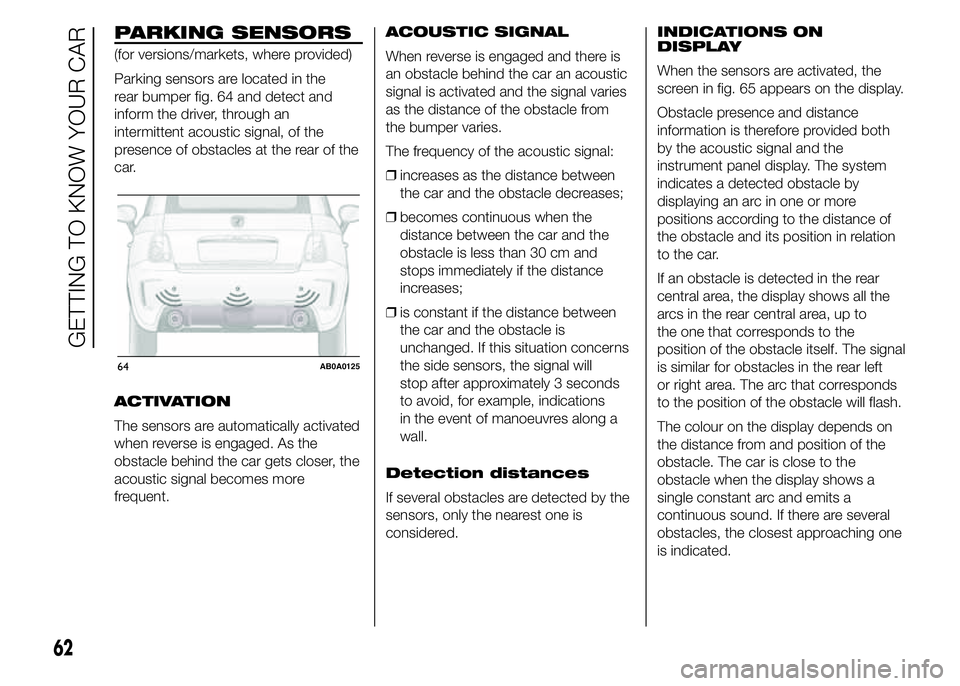
PARKING SENSORS
(for versions/markets, where provided)
Parking sensors are located in the
rear bumper fig. 64 and detect and
inform the driver, through an
intermittent acoustic signal, of the
presence of obstacles at the rear of the
car.
ACTIVATION
The sensors are automatically activated
when reverse is engaged. As the
obstacle behind the car gets closer, the
acoustic signal becomes more
frequent.ACOUSTIC SIGNAL
When reverse is engaged and there is
an obstacle behind the car an acoustic
signal is activated and the signal varies
as the distance of the obstacle from
the bumper varies.
The frequency of the acoustic signal:
❒increases as the distance between
the car and the obstacle decreases;
❒becomes continuous when the
distance between the car and the
obstacle is less than 30 cm and
stops immediately if the distance
increases;
❒is constant if the distance between
the car and the obstacle is
unchanged. If this situation concerns
the side sensors, the signal will
stop after approximately 3 seconds
to avoid, for example, indications
in the event of manoeuvres along a
wall.
Detection distances
If several obstacles are detected by the
sensors, only the nearest one is
considered.INDICATIONS ON
DISPLAY
When the sensors are activated, the
screen in fig. 65 appears on the display.
Obstacle presence and distance
information is therefore provided both
by the acoustic signal and the
instrument panel display. The system
indicates a detected obstacle by
displaying an arc in one or more
positions according to the distance of
the obstacle and its position in relation
to the car.
If an obstacle is detected in the rear
central area, the display shows all the
arcs in the rear central area, up to
the one that corresponds to the
position of the obstacle itself. The signal
is similar for obstacles in the rear left
or right area. The arc that corresponds
to the position of the obstacle will flash.
The colour on the display depends on
the distance from and position of the
obstacle. The car is close to the
obstacle when the display shows a
single constant arc and emits a
continuous sound. If there are several
obstacles, the closest approaching one
is indicated.
64AB0A0125
62
GETTING TO KNOW YOUR CAR
Page 68 of 215
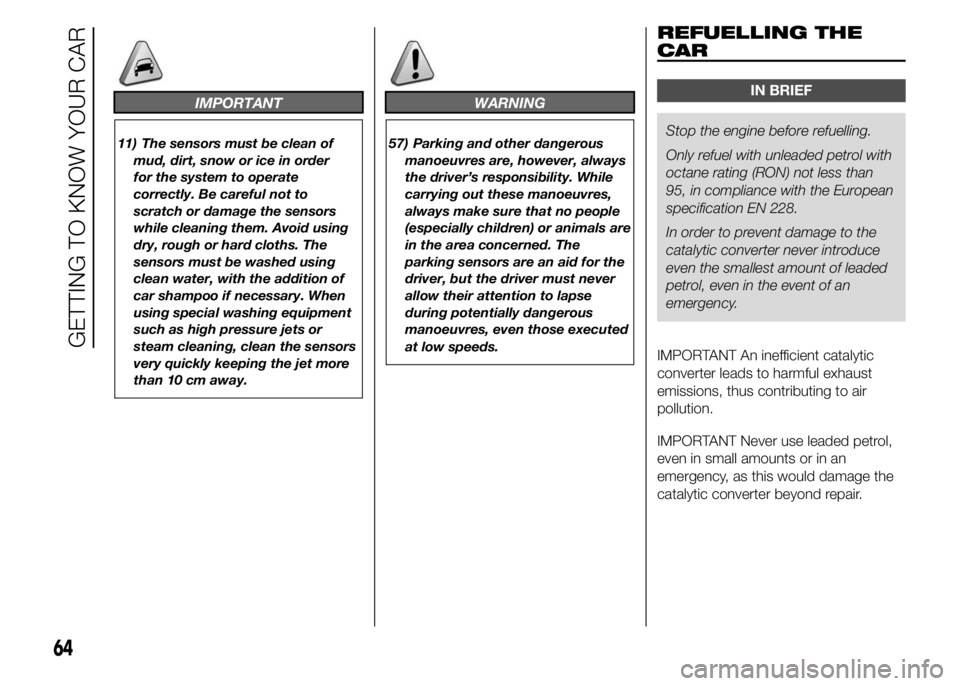
IMPORTANT
11) The sensors must be clean of
mud, dirt, snow or ice in order
for the system to operate
correctly. Be careful not to
scratch or damage the sensors
while cleaning them. Avoid using
dry, rough or hard cloths. The
sensors must be washed using
clean water, with the addition of
car shampoo if necessary. When
using special washing equipment
such as high pressure jets or
steam cleaning, clean the sensors
very quickly keeping the jet more
than 10 cm away.
WARNING
57) Parking and other dangerous
manoeuvres are, however, always
the driver’s responsibility. While
carrying out these manoeuvres,
always make sure that no people
(especially children) or animals are
in the area concerned. The
parking sensors are an aid for the
driver, but the driver must never
allow their attention to lapse
during potentially dangerous
manoeuvres, even those executed
at low speeds.
REFUELLING THE
CAR
IN BRIEF
Stop the engine before refuelling.
Only refuel with unleaded petrol with
octane rating (RON) not less than
95, in compliance with the European
specification EN 228.
In order to prevent damage to the
catalytic converter never introduce
even the smallest amount of leaded
petrol, even in the event of an
emergency.
IMPORTANT An inefficient catalytic
converter leads to harmful exhaust
emissions, thus contributing to air
pollution.
IMPORTANT Never use leaded petrol,
even in small amounts or in an
emergency, as this would damage the
catalytic converter beyond repair.
64
GETTING TO KNOW YOUR CAR
Page 72 of 215

DISPLAY
The car is equipped with a colour
display that, according to the previously
applied settings, will show useful
driving information.
With the ignition key removed, the
display lights up and, depending on the
version, shows the time, the total
odometer reading (in km or miles) and
the 500 logo for a few seconds when a
front door is opened.
NOTE With a low outside temperature
(below 0°C) it may take longer than
normal for information to appear on the
display.COLOUR DISPLAY
"STANDARD" SCREEN
The standard screen fig. 67 can display
the following information:
1Odometer (display of distance
travelled in kilometres/miles)
2Digital engine coolant temperature
gauge
3Digital rev counter
4Gear Shift Indicator
5Date
6Outside temperature gauge
7Car speed indication
8Headlight alignment position (only
with dipped headlights on)
9Time
10eco Index
11Digital fuel level gaugeSPORT MODE
If the SPORT function is used, the
longitudinal/lateral accelerometer
indicator screen (G-meter information)
is displayed automatically. This
considers gravitational acceleration (G)
fig. 68.
2
3
4
5
6
11
10
9
8
7
67AB0A0129
68AB0A0133
68
KNOWING THE INSTRUMENT PANEL
Page 103 of 215

Warning lights on
displayWhat it means What to do
amberSERVICE (SCHEDULED SERVICING)
The symbol is shown on the display together with
a dedicated message, with key at MAR-ON,
2,000 km (or equivalent value in miles) before the
following scheduled servicing interval and is
activated again every 200 km (or equivalent value
in miles).Go to an Abarth Dealership, where the operations
of the "Scheduled Servicing Plan" will be
performed and the message will be reset.
whiteSPEED LIMIT EXCEEDED
(for versions/markets, where provided)
When the car exceeds the speed limit set in the
Setup menu (e.g. 120 km/h), a message and a
dedicated symbol are shown on the display.
ENGAGEMENT OF SPORT FUNCTION
The SPORT indication is shown on the analogue
pressure gauge and the instrument panel shows
a dedicated screen when the "SPORT" function is
engaged by pressing the relevant button on the
dashboard (see the "Controls" paragraph in the
"Knowing your car" chapter). The indication
SPORT will switch off when the button is pressed
again.
99
Page 111 of 215
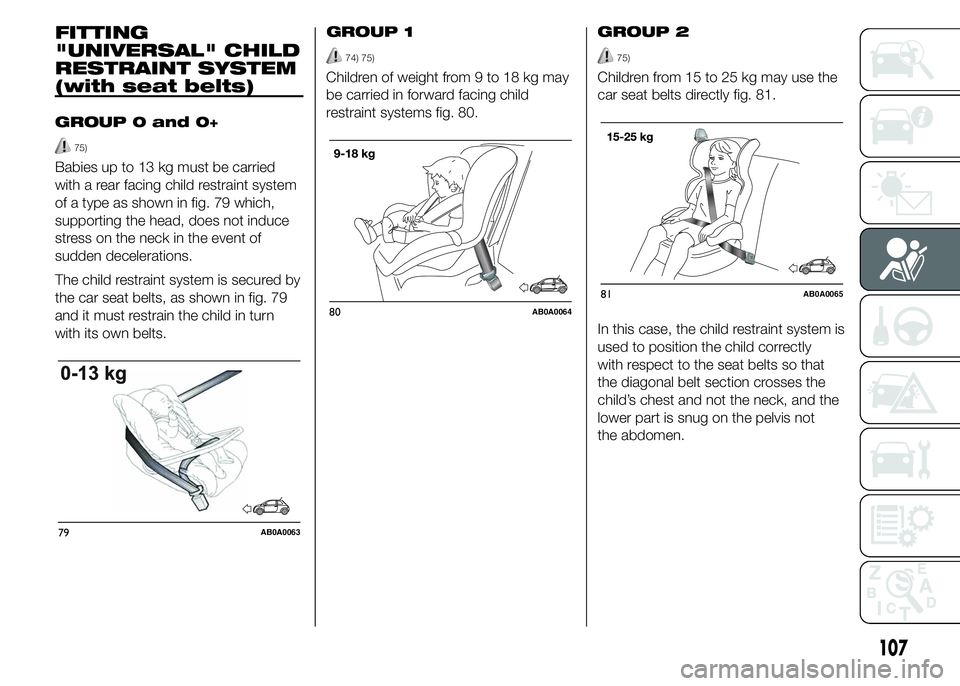
FITTING
"UNIVERSAL" CHILD
RESTRAINT SYSTEM
(with seat belts)
GROUP 0 and 0+
75)
Babies up to 13 kg must be carried
with a rear facing child restraint system
of a type as shown in fig. 79 which,
supporting the head, does not induce
stress on the neck in the event of
sudden decelerations.
The child restraint system is secured by
the car seat belts, as shown in fig. 79
and it must restrain the child in turn
with its own belts.GROUP 1
74) 75)
Children of weight from 9 to 18 kg may
be carried in forward facing child
restraint systems fig. 80.GROUP 2
75)
Children from 15 to 25 kg may use the
car seat belts directly fig. 81.
In this case, the child restraint system is
used to position the child correctly
with respect to the seat belts so that
the diagonal belt section crosses the
child’s chest and not the neck, and the
lower part is snug on the pelvis not
the abdomen.
79AB0A0063
80AB0A0064
81AB0A0065
107
Page 118 of 215

FRONT AIRBAGS
The front driver/passenger airbags and
the driver's knee bag (for versions/
markets, where provided) protect the
front seat occupants in the event of
frontal impacts of medium/high severity,
by placing the bag between the
occupant and the steering wheel or
dashboard.
Therefore non-activation in other types
of collisions (side impacts, rear shunts,
roll-overs, etc.) does not indicate a
system malfunction.
An electronic control unit will make the
bag inflate in the event of a frontal
impact.
The bag will inflate instantaneously
placing itself between the front
occupants body and the structures
which could cause injury. It will deflate
immediately afterwards.
Front airbags are not a replacement of
but complementary to the seat belts,
which you are recommended to always
wear, as specified by law in Europe
and most non-European countries.In the event of an impact, someone not
wearing a seat belt will move forward
and come into contact with the bag
which is still in the opening stage. The
protection offered by the bag is
compromised in these circumstances.
Front airbags may not be activated
in the following situations:
❒frontal impacts against highly
deformable objects not involving the
front surface of the car (e.g. wing
collision against guard rail);
❒jamming of the car underneath other
vehicles or protective barriers (e.g.
underneath a truck or a guard rail)
since the bags would offer no
additional protection with respect to
the seat belt and their deployment
would be inappropriate. In these
cases, non-deployment does not
indicate a system malfunction.
80)
The front airbags (driver, passenger,
driver's knee bags) are designed and
calibrated to protect front seat
passengers wearing seat belts.Their volume at the moment of
maximum inflation fills most of the
space between the steering wheel and
the driver, between the lower steering
column guard and the knees on driver
side and between the dashboard and
the passenger.
The airbags are not deployed in the
event of minor frontal impacts (for
which the restraining action of the seat
belts is sufficient). Seat belts must
always be worn. In the event of frontal
impacts they guarantee correct
positioning of the passenger.
DRIVER'S SIDE FRONT
AIRBAG
This consists of an instantly inflating
cushion contained in a special
compartment in the centre of the
steering wheel fig. 86.
86AB0A0070
114
SAFETY
Page 126 of 215
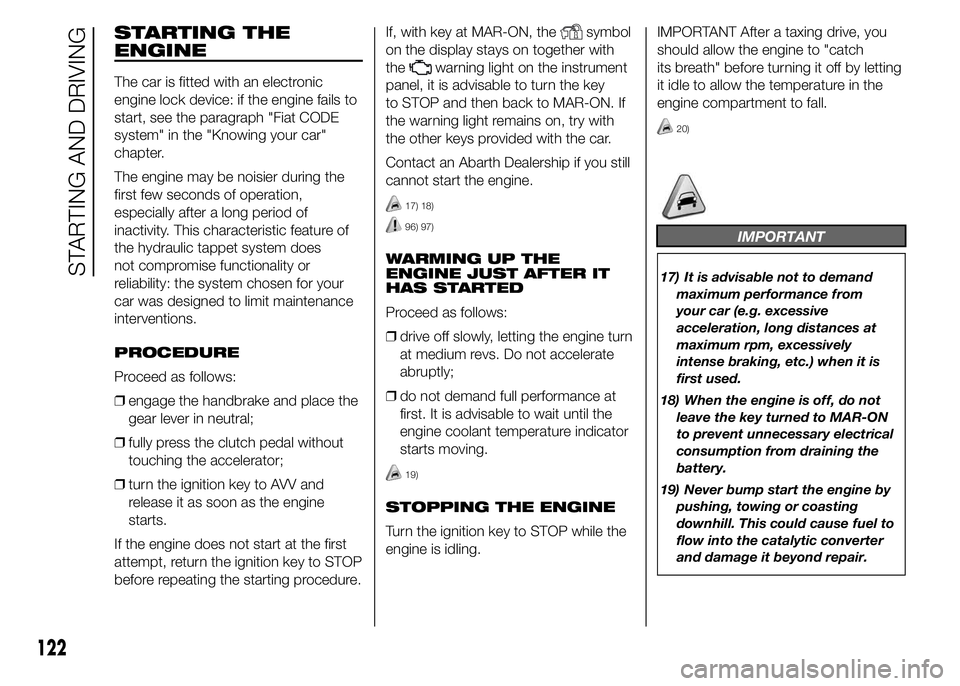
STARTING THE
ENGINE
The car is fitted with an electronic
engine lock device: if the engine fails to
start, see the paragraph "Fiat CODE
system" in the "Knowing your car"
chapter.
The engine may be noisier during the
first few seconds of operation,
especially after a long period of
inactivity. This characteristic feature of
the hydraulic tappet system does
not compromise functionality or
reliability: the system chosen for your
car was designed to limit maintenance
interventions.
PROCEDURE
Proceed as follows:
❒engage the handbrake and place the
gear lever in neutral;
❒fully press the clutch pedal without
touching the accelerator;
❒turn the ignition key to AVV and
release it as soon as the engine
starts.
If the engine does not start at the first
attempt, return the ignition key to STOP
before repeating the starting procedure.If, with key at MAR-ON, the
symbol
on the display stays on together with
the
warning light on the instrument
panel, it is advisable to turn the key
to STOP and then back to MAR-ON. If
the warning light remains on, try with
the other keys provided with the car.
Contact an Abarth Dealership if you still
cannot start the engine.
17) 18)
96) 97)
WARMING UP THE
ENGINE JUST AFTER IT
HAS STARTED
Proceed as follows:
❒drive off slowly, letting the engine turn
at medium revs. Do not accelerate
abruptly;
❒do not demand full performance at
first. It is advisable to wait until the
engine coolant temperature indicator
starts moving.
19)
STOPPING THE ENGINE
Turn the ignition key to STOP while the
engine is idling.IMPORTANT After a taxing drive, you
should allow the engine to "catch
its breath" before turning it off by letting
it idle to allow the temperature in the
engine compartment to fall.
20)
IMPORTANT
17) It is advisable not to demand
maximum performance from
your car (e.g. excessive
acceleration, long distances at
maximum rpm, excessively
intense braking, etc.) when it is
first used.
18) When the engine is off, do not
leave the key turned to MAR-ON
to prevent unnecessary electrical
consumption from draining the
battery.
19) Never bump start the engine by
pushing, towing or coasting
downhill. This could cause fuel to
flow into the catalytic converter
and damage it beyond repair.
122
STARTING AND DRIVING